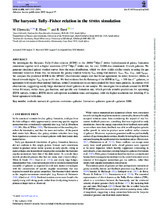The baryonic Tully–Fisher relation in the SIMBA simulation
| dc.contributor.author | Glowacki, M. | |
| dc.contributor.author | Elson, E. | |
| dc.contributor.author | Dave, R. | |
| dc.date.accessioned | 2021-02-08T09:09:21Z | |
| dc.date.available | 2021-02-08T09:09:21Z | |
| dc.date.issued | 2020 | |
| dc.identifier.citation | Glowacki, M. et al. (2020). The baryonic Tully–Fisher relation in the SIMBA simulation. Monthly Notices of the Royal Astronomical Society, 498(3), 3687–3702 | en_US |
| dc.identifier.issn | 1365-2966 | |
| dc.identifier.uri | https://doi.org/10.1093/mnras/staa2616 | |
| dc.identifier.uri | http://hdl.handle.net/10566/5850 | |
| dc.description.abstract | We investigate the Baryonic Tully–Fisher relation (BTFR) in the (100h−1Mpc)3SIMBA hydrodynamical galaxy formation simulation together with a higher resolution (25h−1Mpc)3SIMBA run, for over 10 000 disc-dominated, H I-rich galaxies. We generate simulated galaxy rotation curves from the mass distribution, which we show yields similar results to using the gas rotational velocities. From this, we measure the galaxy rotation velocity Vcirc using four metrics: Vmax,Vflat,V2Re, and Vpolyex. We compare the predicted BTFR to the SPARC observational sample and find broad agreement. In detail, however, SIMBA is biased towards higher Vcirc by up to 0.1 dex. We find evidence for the flattening of the BTFR in Vcirc > 300 km s−1 galaxies, in agreement with recent observational findings. | en_US |
| dc.language.iso | en | en_US |
| dc.publisher | Oxford University Press | en_US |
| dc.subject | Methods: numerical | en_US |
| dc.subject | Galaxies: evolution | en_US |
| dc.subject | Galaxies: formation | en_US |
| dc.subject | Galaxies: general | en_US |
| dc.subject | Galaxies: ISM | en_US |
| dc.title | The baryonic Tully–Fisher relation in the SIMBA simulation | en_US |
| dc.type | Article | en_US |

